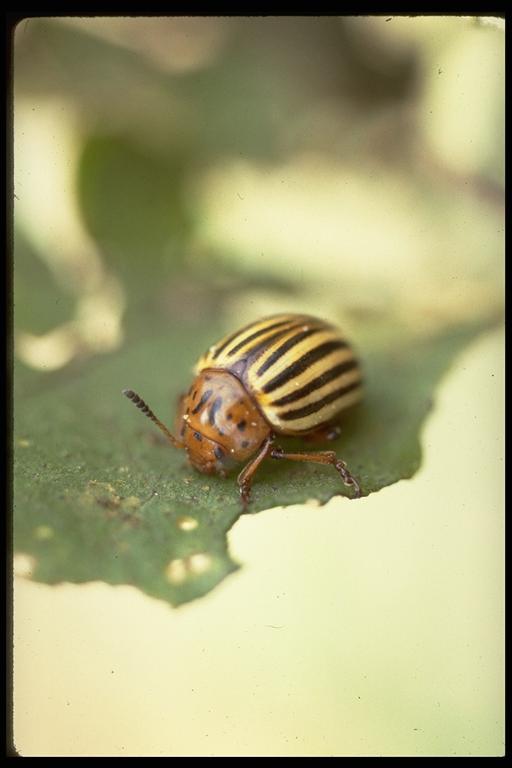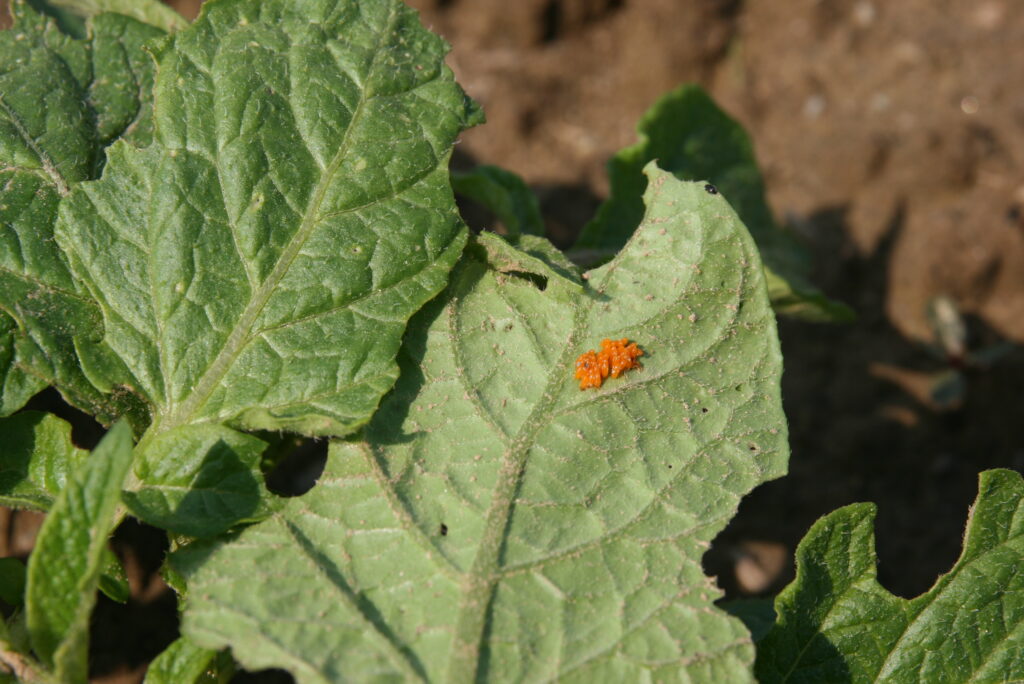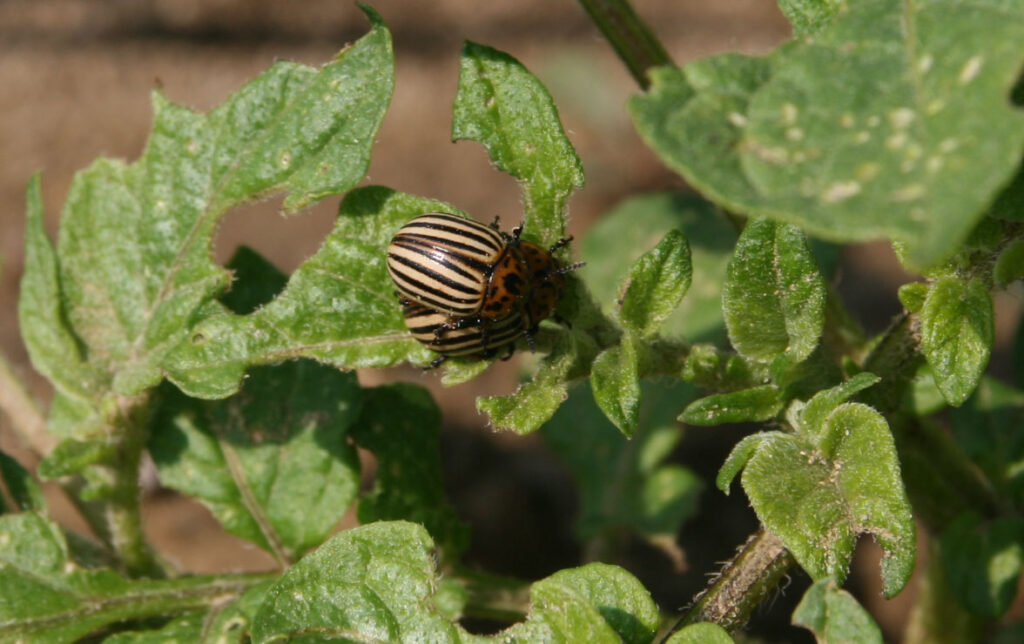
Pest: Colorado Potato Beetle (Leptinotarsa decemlineata)
Pest identification and lifecycle, most common symptoms and crops affected:

As with most other insects and plants, there is a direct relationship between higher temperatures (in the range between about 55 and 90 degrees) and faster rate of development. That includes egg-laying, egg hatch, larval growth and feeding rates. A period of cold, rainy weather can slow everything down, but a surge of adults and eggs can later appear with warm weather.
Colorado potato beetle (CPB) adults most commonly lay eggs in potato and eggplant crops. Their bright orange-yellow eggs are laid in clumps with about 30-35 eggs each, generally on the undersides of leaves.
Look on the undersides of leaves for the orange-yellow egg masses. The fresher the eggs, the brighter orange the eggs will appear. Eggs hatch in 7-10 days, depending on temperature. If you want to know when the earliest eggs are hatching, you can flag a few of the earliest egg masses you find with bright tape or flags, and then keep an eye on the hatch.
Hatched larvae go through four stages before they become adults. In the first stage, the larvae are about the same size as the eggs and in the second stage they are about an eighth of an inch long. As the larvae get bigger, they do more feeding. The fourth, and largest, stage does 85% of the feeding damage. It’s a good idea to prevent larvae from ever reaching the fourth instar! The smaller instars are the easiest to kill.

After larvae complete their growth, they drop and burrow into the ground to pupate. About 10 days later, the next generation of adults emerges — ready to feed. If they emerge before August 1, they will lay more eggs. After August 1, they feed and head to overwintering sites. Good control in June prevents problems with CPB in August.
Walk your potatoes and look for CPB adults and eggs. A treatment should be considered for adults when you find 25 beetles per 50 plants and defoliation has reached the 10% level. The recommended spray threshold for small larvae is four per plant; for large larvae, one and a half per plant (or per stalk in midseason), based on a count of 50 plants or stalks.
Controls are needed on eggplants when there are two small or one large larvae per plant (if plants are less than 6 inches) and four small larvae or two large per plant (if plants are more than 6 inches).

Potatoes can tolerate 20% defoliation without reduction in yield (or even more late in the season). Damage to eggplant seedlings from adult feeding is often severe enough to warrant control of the adults. In potato, adult damage in rotated fields may not be significant, so you may want to wait until after egg hatch to kill both late adults and larvae.
Management options:
Cultural:
Crop rotation is the single most important tactic for CPB management. Rotate potatoes or eggplant to a field that is at least 200 yards from the previous year’s fields. Since the adults that emerge after winter rarely fly, barriers such as roads, rivers, woodlands and fields with other crops are helpful. Rotated fields tend to be colonized (from second generation adults that are more likely to fly) one to four weeks later in the season than non-rotated fields. Also, the total population of adult beetles is lower, producing fewer larvae to control.
Perimeter treatments or perimeter trap cropping can be applied to potato. One approach is to plant a barrier crop between overwintering sites and this year’s crop and get it in earlier than the main crop; then control early-arriving beetles there.
Early planting makes it easier for the crop to put on growth and size before CPB adults and larvae arrive. Green sprouting, also known as chitting, prepares whole seed potatoes to emerge rapidly, gaining about 7-10 days to harvest. It can be combined with raised beds and plasticulture. While it won’t prevent damage altogether, it may reduce the need for insecticides. Refer to the “New England Vegetable Management Guide” for more details.
Late planting is another strategy for beating the beetle. CPB adults that do not find food leave the field in search of greener pastures. Planting after mid-June, using a short-season variety, often prevents CPB damage and eliminates the need for controls.
Straw mulch is another management option. It has been well documented that when potatoes or eggplants are mulched with straw, fewer Colorado potato beetle adults will settle on the plants and fewer eggs will be laid. This can be accomplished on larger plantings by strip planting in a rye mulch, followed by mowing and pushing the rye straw over the plants after they emerge. For smaller plots, straw may be carried in.
Biocontrol options:
There are numerous predators and parasitoids that attack CPB adults, larvae and eggs including tachinid fly, 12-spotted lady beetle, spined soldier bug and ground beetles.
Pesticides approved for use in certified organic production (as a last resort):
Spinosad (Entrust for commercial growers or Monterey Garden Insect Spray for home gardeners) and azadirachtin (Aza-Direct) are two options. Studies have shown very good results with Spinosad, but please use reluctantly because resistance is building up in populations of CPB. Azadirachtin has shown some efficacy, but neem products work slowly. Generally, it is used to reduce overall damage and reduce numbers, but it is not a rescue treatment like Spinosad is. Beauveria bassiana (Mycotrol ESO) has been shown to suppress CPB populations though does not provide immediate control.
Please note: There are label restrictions on the use of Entrust that have been written in to help avoid build-up of resistance. Be sure to follow the label with respect to mixing and the number of times a particular crop may be sprayed per season.
This information is for educational purposes. Any reference to commercial products, trade or brand names is for information only, and no endorsement or approval is intended. Pesticide registration status, approval for use in organic production and other aspects of labeling may change after the date of this writing. It is always best practice to check on a pesticide’s registration status with your state’s board of pesticide control, and for certified organic commercial producers to update their certification specialist if they are planning to use a material that is not already listed on their organic system plan. The use of any pesticide material, even those approved for use in organic production, carries risk — be sure to read and follow all label instructions. The label is the law. Pesticides labeled for home garden use are often not allowed for use in commercial production unless stated as such on the label.
Source material attribution: Modified from the UMass Extension Vegetable Notes, an article by R. Hazzard. Sources include: D. Ferro (UMass Amherst), J. Mishanec (NYS), J. Boucher (CT), J. Whalen (DE), T. Kuhar (VA), G. Ghidhu (NJ), New England Vegetable Management Guide, Ohio Vegetable Production Guide.
